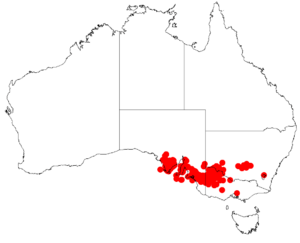Acacia microcarpa facts for kids
Quick facts for kids Acacia microcarpa |
|
|---|---|
| Scientific classification | |
| Genus: |
Acacia
|
| Species: |
microcarpa
|
 |
|
| Occurrence data from AVH | |
Acacia microcarpa, also known as manna wattle, is a type of shrub. It belongs to the large Acacia plant family. This plant grows naturally only in certain parts of south eastern Australia. It is found nowhere else in the world.
Contents
What Does Manna Wattle Look Like?
This shrub usually grows up to about 2.5 meters (8 feet) tall. Its branches have slight angles. The bark on its trunk and main branches is grey and has small cracks.
Leaves and Flowers
The manna wattle has special leaf-like structures called phyllodes. These are not true leaves but look and act like them. They stay green all year round. These phyllodes are smooth and can be 2 to 6 centimeters long. They are usually 4 to 10 millimeters wide.
The shrub blooms, or flowers, between August and November. Its flowers grow in simple, round clusters. Each cluster has 14 to 22 bright to golden-colored flowers.
Seed Pods
After the flowers, long, thin seed pods grow. These pods are green or brown and are usually a bit curved. They can be about 8 centimeters long and 2 to 5 millimeters wide. Inside these pods are dark brown seeds, each about 3 to 4 millimeters long.
How Manna Wattle Got Its Name
The manna wattle was first officially described in 1858. A botanist named Ferdinand von Mueller gave it the scientific name Acacia microcarpa. A botanist is a scientist who studies plants.
The second part of its scientific name, microcarpa, means "small seeds." This name was chosen because the plant has small seeds. For a short time in 2003, it was called Racosperma microcarpum, but it was moved back to the Acacia group in 2006.
Where Does Manna Wattle Grow?
Most manna wattles are found in south eastern Australia. They grow from the Eyre Peninsula in South Australia, all the way to New South Wales and Victoria.
This shrub can grow in many different types of soil. It is often found in sandy or loamy soils. It likes to grow in areas known as "mallee country," which is a type of Australian bushland.

